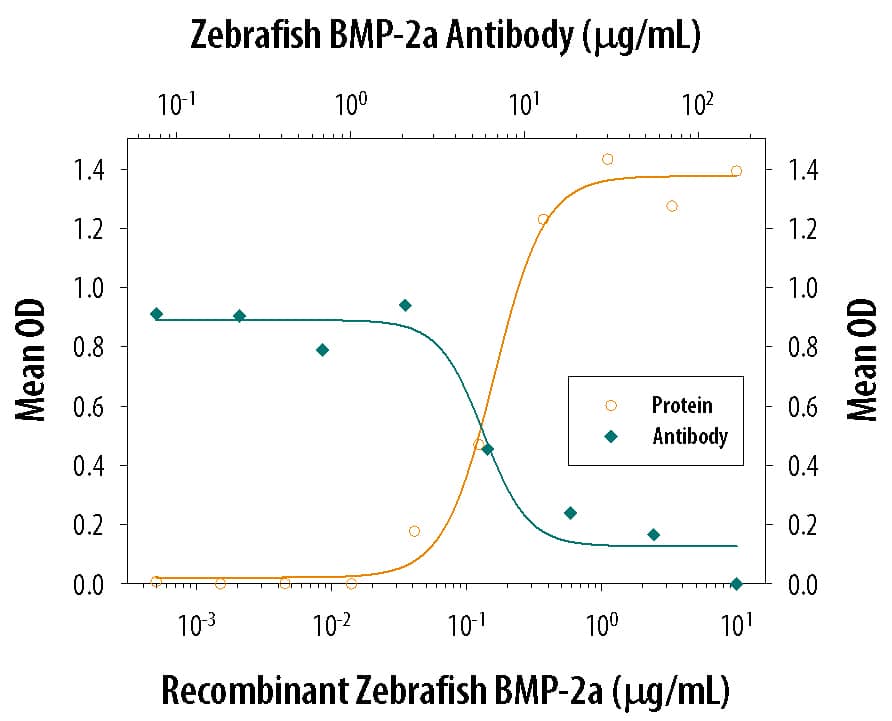Zebrafish BMP-2 Antibody
R&D Systems, part of Bio-Techne | Catalog # MAB111

Key Product Details
Species Reactivity
Applications
Label
Antibody Source
Product Specifications
Immunogen
Gln272-Arg386
Accession # AAI63048
Specificity
Clonality
Host
Isotype
Endotoxin Level
Scientific Data Images for Zebrafish BMP-2 Antibody
Alkaline Phosphatase Production Induced by BMP‑2a and Neutralization by Zebrafish BMP‑2 Antibody.
Recombinant Zebrafish BMP-2a (Catalog # 111-BM) induces alkaline phosphatase production in the ATDC5 mouse chondrogenic cell line in a dose-dependent manner (orange line). Alkaline phosphatase production elicited by Recombinant Zebrafish BMP-2a (1 µg/mL) is neutralized (green line) by increasing concentrations of Mouse Anti-Zebrafish BMP-2 Monoclonal Antibody (Catalog # MAB111). The ND50 is typically 5-25 µg/mL in the presence of heparin (2 µg/mL).Applications for Zebrafish BMP-2 Antibody
Western Blot
Sample: Recombinant Zebrafish BMP-2a (Catalog # 111-BM)
Neutralization
Formulation, Preparation, and Storage
Purification
Reconstitution
Formulation
Shipping
Stability & Storage
- 12 months from date of receipt, -20 to -70 °C as supplied.
- 1 month, 2 to 8 °C under sterile conditions after reconstitution.
- 6 months, -20 to -70 °C under sterile conditions after reconstitution.
Background: BMP-2
BMP-2 is one of at least 20 structurally and functionally related BMPs, which are members of the transforming growth factor beta (TGF‑ beta) superfamily (1, 2). BMPs were originally identified as protein regulators of cartilage and bone formation. However, they are also involved in embryogenesis and morphogenesis of various tissues and organs. BMPs regulate the growth, differentiation, chemotaxis, and apoptosis of various cell types, including mesenchymal cells, epithelial cells, hematopoietic cells, and neuronal cells. Similarly to other TGF-beta family proteins, BMPs are highly conserved across animal species. At the amino acid sequence level, mature human, mouse, and rat BMP-2 share 100% amino acid (aa) sequence identity, while mature human BMP-2 and zebrafish BMP-2 share 85% aa identity. Zebrafish have another homolog of BMP-2 (also called BMP-2a) called BMP-2b, which is 88% identical to BMP-2 in the mature region and corresponds to the swirl mutant. The combined expression pattern of zfBMP-2a/2b/4 coincides with areas where BMP-2/4 expression would be found in other vertebrates (3). Biologically active BMP-2 is a disulfide-linked homodimer of the carboxy-terminal 115 amino acid residues that contains the characteristic seven conserved cysteine residues involved in the formation of the cysteine knot and the single interchain disulfide bond. Cellular responses to BMP-2 have been shown to be mediated by the formation of hetero‑ogliomeric complexes of type I and type II serine/threonine kinase receptors (4). In contrast to the TGF-beta type I receptor, which does not bind the ligand in the absence of the TGF-beta receptor type II, both type I BMP receptor’s can bind BMP-2 with high affinity in the absence of BMP receptor type II.
References
- Ryoo, H.M. et al. (2006) Gene 366:51.
- Chen, D. et al. (2004) Growth Factors 22:233.
- Martinez-Barbera, J. et al. (1997) Gene 198:53.
- Miyazono, K. et al. (2005) Cytokine Growth Factor Rev. 16:251.
Long Name
Alternate Names
Gene Symbol
UniProt
Additional BMP-2 Products
Product Documents for Zebrafish BMP-2 Antibody
Product Specific Notices for Zebrafish BMP-2 Antibody
For research use only
